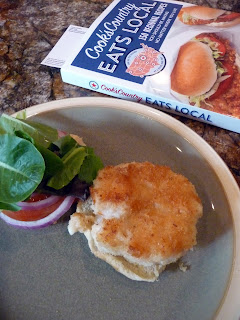Almost any protein can be made into a burger. Beef may reign supreme, but lamb and turkey have made their inroads. However, some of the best burgers are those made with fish. In the past, I have prepare dishes such as
Salmon Burgers and
Rockfish Burgers, both of which were paired with variations of guacamole. I actually prefer those types of burgers over a beef burger (but not a lamb burger).
Given the myriad of possibilities when it comes to proteins and burgers, I am always on the lookout for something new and different. A few months back, my beautiful wife, Clare, and I -- along with our kids -- went to the Library of Congress' book festival At that festival, I picked up the Cook's Country Eats Local. It was a great purchase, because the book has all sorts of interesting recipes from around the country, including one for South Carolina Shrimp Burgers.
The connection between South Carolina and shrimp is an obvious one, especially for a food lover such as myself. There is a long history of shrimping in the low country, with generation after generation plying the waters catching one of the three types of shrimp that thrive in the area. Each type corresponds to a color. There is the brown shrimp or Farfantepenaeus Aztecus. There is the white shrimp or Litopenaues Setiferus. And there is the pink shrimp or Litopenaue Duorarum. Three types of shrimp, that all basically taste the same.
The true difference in shrimp comes from using fresh shrimp and frozen shrimp. Unless you live in the low country, or by a body of water where shrimpers ply their trade, you are most likely eating frozen shrimp. This is even true if you buy them at the seafood counter of your local grocery store. (The shrimp arrive at the store frozen, but the store's seafood staff takes care of that whole defrosting thing.) While fresh shrimp are definitely the best, you can use frozen shrimp provided that those shrimp did not have to travel half of the globe to make it to your local supermarket. In other words, look for shrimp that is as "local" as you can get. If you are in a city such as Charleston, South Carolina, or Chicago, Illinois, you are better off if your shrimp is from the United States, as opposed to Thailand or Ecuador. While it may cost more to buy shrimp harvested in the United States, you are at least supporting local fishermen and shrimpers, which is a good thing.
The authors of the Cook's Country book also recommend that you should use "untreated shrimp," that is, shrimp that does not have added sodium or preservatives, such as sodium tripolyphosphate (STPP). This would pretty much rule out most, if not all, of the shrimp that you find in the freezer section of your grocery store. Once the freezer section declared off limits, you are left with the seafood counter, where you can buy some seemingly-fresh-but-previously-frozen shrimp for this burger recipe. You will not regret it.
In the end, this is a great recipe. I have already made these shrimp burgers for family and friends. The recipe is quickly becoming a family favorite, which ensures it will be made again and again. Too bad we don't live closer to the shore where we could get our shrimp right off of the boat.
SOUTH CAROLINA SHRIMP BURGERS
Recipe from Cook's Country Eats Local, pages 114-115
Serves 4
Ingredients (for the burgers):
1 cup of panko bread crumbs
1 1/4 pounds of large shrimp (26/30 count),
peeled, deveined, and tails removed
2 tablespoons mayonnaise
1/4 teaspoon pepper
1/8 teaspoon salt
3 scallions, chopped fine
3 tablespoons of vegetable oil
4 hamburger buns
4 leaves Bibb lettuce
Ingredients (for the tartar sauce):
3/4 cup mayonnaise
3 tablespoons finely chopped dill pickles
1 small shallot, minced
1 teaspoon capers, rinsed and chopped fine
1/4 teaspoon pepper
Directions:
1. Make the tartar sauce. Combine all of the ingredients in a bowl and refrigerate until needed.
2. Begin making the burgers. Pulse the panko crumbs until finely ground, about 15 pulses, transfer to a shallow dish. Place one-third of shrimp (1 cup), mayonnaise, pepper, salt, and cayenne in the now-empty and pulse until shrimp are finely chopped, about 8 pulses. Add remaining two-third of shrimp (2 cups) to shrimp mixture in processor and pulse until coarsely chopped, about 4 pulses, scraping down sides of bowl as needed. Transfer shrimp mixture to a bowl and stir in the scallions.
3. Make the patties. Divide shrimp mixture into four 3/4 inch thick patties (about 1/2 cup each). Working with 1 patty at a time, dredge both sides of batties in panko, pressing lightly to adhere, and transfer to plate.
4. Cook the burgers. Heat oil in 12 inch non-stick skillet over medium heat until shimmering. Place patties in skillet and cook until golden brown on first side, about 3 to 5 minutes. Carefully flip and continue to cook until the shrimo registers 140 to 145 degrees and second side is golden brown, 3 to 5 minutes longer. Transfer burgers to paper towel-lined plate and let drain, about 30 seconds each side. Spread tartar sauce on bun bottoms, then place burgers on top. Cover with lettuce and bun tops. Serve.
ENJOY!









